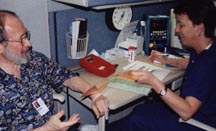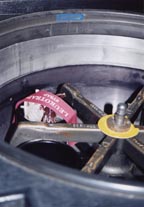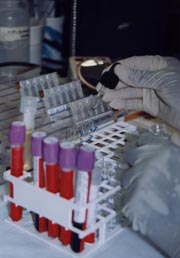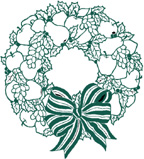
| Home | Contact Us | Site Map | Search |
 |
||||
|
|
|
|
|
| |
|||||||||||||||||||||||||||||||||||||||||||||
|
This file is provided for reference purposes only. It was current when it was produced, but it is no longer maintained and may now be out of date. Persons with disabilities having difficulty accessing information may contact us for assistance. For reliable, current information on this and other health topics, we recommend consulting the NIH Clinical Center at http://www.cc.nih.gov/.

|
|||||||||||||||||||||||||||||||||||||||||||||
CC director honors staff with awardsCC Director Dr. John Gallin praised CC employees for their many contributions this year during the annual address and awards ceremony on Nov. 13. The event, which was held in Masur Auditorium, began with a moment of silence to remember CC employees that have died this year. They included Dr. John Doppman, Dr. John Decker, Michael Pometto, Jr., and Bene Svitavsky. Dr. Gallin applauded CC employees for their resiliency, during what he called the "trying" times of the 1980s and '90s. He noted that several factors had affected staff here, such as low patient enrollment, budget cuts, and the impact of managed care. Since last year, the CC has experienced a surge in inquiries and referrals, and has even increased new patient enrollment by 164 percent. "As a result of the increase in patients, more departments are seeing more patients," said Dr. Gallin. "This could easily negatively affect our staff." But it seems quite the opposite has happened. Researchers and staff from numerous departments have been recognized nationally for their hard work, and their unsurpassed professionalism and expertise have been exemplified in the successes of the institute. Dr. Gallin highlighted numerous accomplishments, including an excellent rating by the Joint Commission on the Accreditation of Healthcare Organizations, which conducted a survey of our facility on Nov. 1-3. "We received terrific grades," said Dr. Gallin. "Our staff should be commended for their outstanding work preparing for this important visit." In addition, Dr. Gallin discussed several CC initiatives, including the Imaging Sciences Program, Hospitality Services, the Cybercafe, the Family Lodge, and the Patient Advisory Group. "I am very optimistic and excited about what has happened at the CC this past year," said Dr. Gallin. "I want to sincerely thank everyone for their contributions. Next year is going to be even more exciting." In the category of administration, awards went to:
Jesse Ferguson Customer Service awards went to:
Patient Care awards went to:
In the category of science, an award went to:
In the category of strategic initiatives, awards went to:
Teaching/Training awards went to:
Keystone awards went to:
Framed certificates, in recognition of exemplary service as co-chair of the Clinical Center Women Scientists Group, went to:
|
|||||||||||||||||||||||||||||||||||||||||||||
|
"We would wait until the last day of our mission and then squeeze the patients who might need this treatment into the bus with us." --Dr. John Hurley |
As you excitedly tear the wrapping off your gifts this holiday season, consider for a moment those who don't quite have the same luxuries; those whose concerns are more than just what colors this season's trendy new sweaters come in, but who instead worry about one of life's basicsÑmedical care. It's just those concerns that led Dr. John Hurley, head of the CC pediatric outpatient clinic, to visit the Dominican Republic late last summer, bringing medical care to children in some of the most remote areas of the region.
For the second year, Dr. Hurley has been a part of a medical mission to Guayabal, a small village nestled in the mountains of the Dominican Republic. A region plagued with poverty and associated problems, Guayabal has for the past 10 years benefited from visits from a medical team consisting of physicians, dentists, nurses, pharmacists, and interpreters from across the country.
"The purpose of this medical mission was to reach out to remote areas of the Dominican Republic and offer them some of the basic health care we take for granted in the U.S.," said Dr. Hurley. "Our role was to offer medical and dental services to those with little healthcare and even less knowledge of preventive medicine."
And offer they did. Collectively the medical team of about 80 health professionals treated more than 300 patients a day, during their week-long visit.
Patients received basic medical care, and although the staff did not have access to diagnostic equipment such as an x-ray machine, they were able to set up a basic laboratory for urinalyses, blood counts, and blood sugar testing. Individuals young and old were seen for numerous illnesses, many of which are the common problems related to poverty, such as malnutrition and unsafe drinking water. According to Dr. Hurley, some of the medical problems that the children exhibited resulted from inadequate dental hygiene. "Many suffer from horrible tooth decay due to lack of fluoride in their water supply, as well as their tendency to suck on sweets, such as sugar cane," he said. "But that's not only a problem when they are children. As they grow older and have children of their own, it remains a problem." Due to lack of resources available for purchasing formulas, successful breastfeeding is essential for infant survival," said Dr. Hurley.
However, inadequate oral hygiene in adults leads to chronic mouth infections, and ultimately to a decline in the nursing mother's ability to produce sufficient breast milk. "I saw one infant last year who was literally starving to death due to his mother's multiple tooth abscesses,"said Dr. Hurley. "Fortunately the dentist was able to extract all her teeth, a horrible ordeal for such a relatively young person, but that cleared her infection and she was able to nurse her baby. It wasn't because she was poor that her baby was dying; it was because of her inability to take care of her teeth."
The medical team also saw patients with unusual infections of the skin, and sometimes even the bone. As children run and play, they often fall and get scrapes and cuts. According to Dr. Hurley, most of the time these cuts heal on their own, but when they don't, it leads to infections under the skin that can spread throughout the body, and even into the bones. "Typically antibiotics by mouth clear these infections very well," he said. "But when it gets into their bones, these children need to be in the hospital to receive antibiotics by vein. We would wait until the last day of our mission and then squeeze the patients who might need this treatment into the bus with us. There is a children's hospital in Santo Domingo, but it is a 4-hour bus ride away, and there weren't any ambulances we could call."
About a quarter of those who visited the region, including Dr. Hurley and other NIH physicians, are members of St. Raphael's Church in Rockville. The rest were members of churches in Florida and Arizona. "This was primarily a medical mission, not a religious mission," said Dr. Hurley. "We were going there not to convert people, but everyone on the mission had a pretty firm belief that this is God's work, and that's what motivated us. St Raphael's has a "sister" parish in Guayabal, and the mission is one way of us reaching out." If you are interested in donating any over-the-counter medications or would like to participate in the August 2001 mission, please contact Dr. Hurley at jhurley@mail.cc.nih.gov, or call 4-7850. Physicians, nurses, pharmacists, lab techs, interpreters and "go-fers" are welcome to call. --by LaTonya Kittles
A Day in the Life of a Pint of Blood . . . A CC News Pictorial |
|
|
Here in the Clinical Center, as around the world, a pint of blood is worth its weight in gold. Everyday, CC patients receive blood transfusions for life-saving surgeries, as well as for the treatment of various illnesses, including leukemia, organ transplants, and others. Journey with us through the day in the life of a pint of blood. As you'll see, the ease of the process alone can make it well worth helping to save a life. --story
by Dina Dariotis |
|
 |
Step 1: Recruiting donors DTM staff inventory the CC blood supply daily to determine if there are shortages. If the staff find that the blood bank is low on a particular blood type, they contact donors who have the needed blood type. "O-type blood, which is found in only 38 percent of the population, is currently in high demand, and there is a low supply in the blood bank," said Brenda Phillips, DTM donor resources coordinator. "So we are constantly looking for people who have this type, as well as others." When blood donors arrive at the DTM, they complete a short application and go to a screening booth, where they answer health history questions and receive a "mini-physical," which includes a check of blood pressure and heart rate. Once they are cleared and complete this process, they are taken to the donation area. |
 |
The actual act of donating blood is relatively quick and painless. The entire process takes approximately 10 to 15 minutes to complete. Donors sit in comfortable lounge chairs as a nurse extracts one pint of blood by placing a needle into the donor's arm. After the donation, DTM gives donors snacks and drinks to help replenish fluids lost during blood donation. |

|
Step 3: Blood separation and analysis Once the blood is collected, a technician pours samples into tiny test tubes. Lab technicians use the samples to test the blood for several factors, including blood type, cholesterol, and infectious diseases.Technicians place the remaining blood into a centrifuge machine, which separates the blood into three major components: red blood cells, plasma, and platelets. The extracted blood components are "quarantined" in a refrigeration unit while all of the necessary blood tests are conducted. If the blood test results are acceptable, the pint is cataloged and stored in a large, silver refrigerator known as the "blood bank." The healthy blood can remain in the bank for up to 42 days. DTM staff place great emphasis on record-keeping and tracking to ensure that all blood donations can be traced to the correct donors and recipients. It takes 48 to 72 hours for donated blood to be ready to be transfused into a CC patient. |
 |
Step 4: Crossmatching When a doctor requests blood from DTM, another test known as a "crossmatch" is conducted to determine if a specific donor's blood is compatible with the patient who needs the transfusion. If possible, DTM staff make every effort to provide blood recipients with blood from one donor, rather than from multiple donors. Step 5: Blood transfusion to the patient Once all of the appropriate tests are conducted, the blood is delivered to the patient-care unit. There, a health-care provider transfuses the blood into the patient. |
Donating blood at the CCBlood transfusions save the lives of patients at the CC and at hospitals throughout the world. Without an adequate supply of donated blood, many patients would not survive. As is the case nationwide, the potential for a blood shortage at the CC in the coming year is significant. The DTM is preparing for this by seeking more volunteers to donate blood. The NIH Blood Bank, which is located in the CC, is open: Tuesday - Friday 7:30 a.m. to 5:30 p.m. In order to attract more donors, DTM aims to make blood donation as convenient as possible by providing free parking adjacent to the DTM. For more information call 6-1048. On the web: http://www.cc.nih.gov/dtm |
|
briefs |
 Holiday
events
Holiday
events
The recreation therapy section invites CC staff and patients to participate in various holiday activities, including: Dec. 7: A holiday concert featuring The Washington Chorus, 7 p.m., 14th floor assembly hall. Dec. 11: A trip to the National Christmas Tree, 6:30 p.m. Dec. 13: Children's holiday around the world party, 6 p.m., 14th floor assembly hall. Dec. 14: The NIH Chamber Singers, featuring songs of the season, 7:30 p.m., 14th floor assembly hall. Dec. 18: Santa's visits, 1:30 p.m. Dec. 19: Holiday concert featuring the Augmented 8, 7 p.m., 14th floor assembly hall. Dec. 24: Christmas Eve caroling, 6:30 p.m., nursing units. For more information, call 6-2278.
No more receipts
The annual receipt drives to benefit the NIH School has new rules–no more receipts needed. To help the NIH School earn free educational equipment, shoppers at Safeway and Giant Foods need only register for a club card and give the school code: Giant #2983, and Safeway #0623. Then registered shoppers will automatically earn credit for the school every time they use their club cards. The NIH School can even earn double credit when customers purchase selected products which are clearly designated at the stores. Both the Safeway Club Card for Education Program, and the Giant A+ Bonus Bucks Program run until the end of March 2001. For more information call the NIH School at 6-2077, or e-mail: hmays@mail.cc.nih.gov.
http://www.giantfood.com/bonuscard_aplus.htm
Clinical research training
Applications for the 2001-2002 NIH-Duke Training Program in Clinical Research are now available in Room B1L403. Designed primarily for clinical fellows and other health professionals training for careers in clinical research, the program offers formal courses in research design, statistical analysis, health economics, research ethics, and research management. Courses for this program are offered at the CC by means of videoconferencing from Duke or onsite by adjunct faculty. Students completing the required coursework are awarded a Master of Health Sciences in Clinical Research from Duke University School of Medicine. Prospective participants should consult with their institute or center regarding the official training nomination procedure. Applications must be received by March 1, 2001.
Open season
The Thrift Savings Plan open season runs through Jan. 31, 2001. FERS employees hired before July 1, 2000, as well as CSRS employees, have an opportunity to make an initial election, or change their current election. For more information, contact human resources at 6-6219.
Foil the Flu
OMS is now offering flu vaccinations to NIH employees. As usual, on-campus opportunities for immunization will be done based on the first letter of the employee's last name. Staff are reminded to bring their NIH ID cards. For more information, call OMS at 6-4411. Hours to receive vaccinations are from 7:30 a.m. to 11 a.m. and from 1 to 4 p.m. on the dates listed:
| 1st letter, last name |
Date
|
|
| N, O, P, Q |
Dec.
1
|
|
| R, S, T, U, V |
Dec.
4
|
|
| W, X, Y, Z |
Dec.
5
|
|
| A, B, C, D, E, F |
Dec.
6
|
|
| G, H, I, J, K |
Dec.
7
|
|
| L, M, N, O, P, Q |
Dec.
8
|
|
| Open - any letter |
Dec.
15
|
|
| Open - any letter |
Dec.
18
|
|
| Open - any letter |
Dec.
19
|
|
|
Any
letter, appointment only, beginning Dec. 20.
|
||
|
Clinical Center News, 6100 Executive Blvd., Suite 3C01, MSC 7511, National Institutes of Health, Bethesda, MD 20892-7511. Tel: 301-496-2563. Fax: 301-402-2984. Published monthly for CC employees by the Office of Clinical Center Communications, Colleen Henrichsen, chief. News, article ideas, calendar events, letters, and photographs are welcome. Deadline for submissions is the second Monday of each month. |
|
|